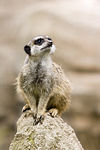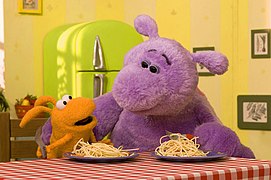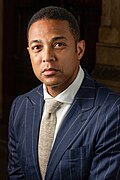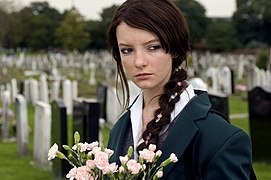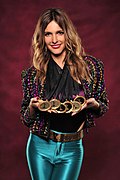Portal:Television
Portal maintenance status: (July 2018)
|
The Television Portal

Television (TV) is a telecommunication medium for transmitting moving images and sound. Additionally, the term can refer to a physical television set, rather than the medium of transmission. Television is a mass medium for advertising, entertainment, news, and sports. The medium is capable of more than "radio broadcasting", which refers to an audio signal sent to radio receivers.
Television became available in crude experimental forms in the 1920s, but only after several years of further development was the new technology marketed to consumers. After World War II, an improved form of black-and-white television broadcasting became popular in the United Kingdom and the United States, and television sets became commonplace in homes, businesses, and institutions. During the 1950s, television was the primary medium for influencing public opinion. In the mid-1960s, color broadcasting was introduced in the U.S. and most other developed countries.
In 2013, 79% of the world's households owned a television set. The replacement of earlier cathode-ray tube (CRT) screen displays with compact, energy-efficient, flat-panel alternative technologies such as LCDs (both fluorescent-backlit and LED), OLED displays, and plasma displays was a hardware revolution that began with computer monitors in the late 1990s. Most television sets sold in the 2000s were flat-panel, mainly LEDs. Major manufacturers announced the discontinuation of CRT, Digital Light Processing (DLP), plasma, and even fluorescent-backlit LCDs by the mid-2010s. LEDs are being gradually replaced by OLEDs. Also, major manufacturers have started increasingly producing smart TVs in the mid-2010s. Smart TVs with integrated Internet and Web 2.0 functions became the dominant form of television by the late 2010s. (Full article...)
Selected article - show another
Selected image - show another

| Credit: National Broadcasting Company/public domain |
W2XBS, Schenectady, New York. In 1928, Felix the Cat was one of the first images ever broadcast by television when RCA chose a papier-mâché Felix doll for an experimental broadcast on W2XBS. The doll was chosen for its tonal contrast and its ability to withstand the intense lights needed in early television and was placed on a rotating phonograph turntable and televised for about two hours each day. The doll remained on the turntable for nearly a decade as RCA fine-tuned the picture's definition, and converted to electronic television.
Did you know (auto-generated) - load new batch

- ... that before being restored as a Broadway theater, the Ritz Theatre was used as a television studio, pornographic theater, vaudeville house, children's theater, and poster warehouse?
- ... that the European version of the video game Tomba! uses the theme song of the television series No Sweat as its opening theme?
- ... that after starting Los Angeles Spanish-language television station KVEA, a group led by Saul Steinberg bought other Spanish-language stations to form the Telemundo network?
- ... that radio station KWKC dropped its application for a TV station in order to speed the arrival of television to Abilene, Texas, which would otherwise have been 89th in line?
- ... that a scene from the television adaptation of the manga It's All About the Looks was filmed at the Tokyo Girls Collection fashion show?
- ... that Laura Robinson invented Canada's best-selling board game before becoming a successful actress and television producer?
Selected quote - show another
| Television is for appearing on, not looking at. |
More did you know
- ...that The Simpsons' history began when Matt Groening conceived of the dysfunctional family in the lobby of James L. Brooks's office?
- ...that the 1994 Guinness television advertisement Anticipation used jump cutting techniques to make an actor appear to be performing a physically impossible dance?
- ...that children up to the age of five can find it difficult to distinguish between television programmes and toy advertising campaigns?
- ...that Robert Raymond founded Australia's longest running current affairs television program?
- ...that the television series ER aired an episode based on the 2003 Chicago balcony collapse?
Selected biography - show another

George Formby OBE (born George Hoy Booth; 26 May 1904 – 6 March 1961) was an English actor, singer-songwriter and comedian who became known to a worldwide audience through his films of the 1930s and 1940s. On stage, screen and record he sang light, comic songs, usually playing the ukulele or banjolele, and became the UK's highest-paid entertainer.
Born in Wigan, Lancashire, he was the son of George Formby Sr, from whom he later took his stage name. After an early career as a stable boy and jockey, Formby took to the music hall stage after the early death of his father in 1921. His early performances were taken exclusively from his father's act, including the same songs, jokes and characters. In 1923 he made two career-changing decisions – he purchased a ukulele, and married Beryl Ingham, a fellow performer who became his manager and transformed his act. She insisted that he appear on stage formally dressed, and introduced the ukulele to his performance. He started his recording career in 1926 and, from 1934, he increasingly worked in film to develop into a major star by the late 1930s and 1940s, and became the UK's most popular entertainer during those decades. The media historian Brian McFarlane writes that on film, Formby portrayed gormless Lancastrian innocents who would win through against some form of villainy, gaining the affection of an attractive middle-class girl in the process. (Full article...)General images
-
Image 1DBS satellite dishes (from History of television)
-
Image 2The Nipkow disk. This schematic shows the circular paths traced by the holes, which may also be square for greater precision. The area of the disk outlined in black shows the region scanned. (from History of television)
-
Image 4RCA 630-TS, the first mass-produced television set, which sold in 1946–1947 (from History of television)
-
Image 6A color television test at the Mount Kaukau transmitter site, New Zealand in 1970.
A test pattern with color bars is used to calibrate the signal. (from Color television) -
Image 7Smart TVs on display (from Smart TV)
-
Image 9Samsung's discontinued Orsay platform (from Smart TV)
-
Image 10The first mass-produced Czechoslovak TV-set Tesla 4001A (1953–57) (from History of television)
-
Image 11Ad for the beginning of experimental television broadcasting in New York City by RCA in 1939 (from History of television)
-
Image 12RCA CT-100 at the SPARK Museum of Electrical Invention playing Superman. The RCA CT-100 was the first mass-produced color TV set. (from Color television)
-
Image 13Color bars used in a test pattern, sometimes used when no program material is available (from History of television)
-
Image 14Public television in France uses 819 line b&w high definition, from 1959 until 1983 (TF1). (from History of television)
-
Image 15The Philco Predicta, 1958. In the collection of The Children's Museum of Indianapolis (from History of television)
-
Image 16This live image of actress Paddy Naismith was used to demonstrate Telechrome, John Logie Baird's first all-electronic color television system, which used two projection CRTs. The two-color image would be similar to the basic Telechrome system. (from Color television)
-
Image 17Family watching TV, 1958 (from History of television)
-
Image 18LG Smart TV using the Web browser (from Smart TV)
-
Image 19Comparison of image quality between ISDB-T (1080i broadcast, top) and NTSC (480i transmission, bottom) (from Digital television)
-
Image 20LG Electronics smart TV from 2011 (from Smart TV)
-
Image 21First television test broadcast transmitted by the NHK Broadcasting Technology Research Institute in May 1939 (from History of television)
-
Image 22An early Smart TV from 2012 running the discontinued Orsay platform (from History of television)
-
Image 23Philo Farnsworth in 1924 (from History of television)
-
Image 25Baird in 1925 with his televisor equipment and dummies "James" and "Stooky Bill" (right) (from History of television)
 Featured lists - load new batch
Featured lists - load new batch
-
Image 1

Stone in 2016
Emma Stone is an American actress who aspired to an acting career from an early age. She had her first role onstage at age 11, and followed with parts in sixteen plays in a regional theater in Arizona. Stone made her television debut in the unsold pilot for the reality show The New Partridge Family (2005). After brief television roles in Medium, Malcolm in the Middle, and Lucky Louie, she made her film debut in the comedy Superbad (2007).
Stone appeared as a ghost in Ghosts of Girlfriends Past (2009), and found commercial success with the horror comedy Zombieland. Her breakthrough came with her first leading role as a high school student perceived to be sexually promiscuous in the comedy Easy A (2010). In 2011, she starred in the romantic comedy Crazy, Stupid, Love and in the period drama The Help, which were both commercial successes. Stone's success continued with her role as Gwen Stacy in the 2012 superhero film The Amazing Spider-Man that became her highest-grossing release, with a worldwide revenue of $757 million, and she later reprised the role in its 2014 sequel. Critical success followed with her performance as a recovering drug addict in Alejandro González Iñárritu's black comedy-drama Birdman (2014). It earned her a nomination for the Academy Award for Best Supporting Actress. Later that year, she made her Broadway debut in a revival of the musical Cabaret. (Full article...) -
Image 2Kristen Schaal's portrayal of Sarah Lynn in the episode "That's Too Much, Man!" earned her a nomination for the Primetime Emmy Award for Outstanding Character Voice-Over Performance.
BoJack Horseman is an American adult animated tragicomedy created by Raphael Bob-Waksberg. Presented as a sitcom set primarily in Los Angeles, the series tells the story of the eponymous anthropomorphic horse (voiced by Will Arnett), who is a washed-up star of a 1990s sitcom who plans his return to celebrity relevance with an autobiography to be written by human ghostwriter Diane Nguyen (Alison Brie). He also has to contend with his cat agent Princess Carolyn (Amy Sedaris), human roommate Todd Chavez (Aaron Paul), and former dog rival Mr. Peanutbutter (Paul F. Tompkins), as well as his struggles with depression and addiction. The series premiered on Netflix on August 22, 2014, and concluded on January 31, 2020, after six seasons and 77 episodes.
Despite mixed reviews upon its debut, critics were significantly more positive towards the second half of the first season, and the subsequent seasons received widespread critical acclaim. GQ hailed the show as one of the best of the decade, and IndieWire ranked BoJack Horseman as the greatest animated TV show of all time. The show has been lauded for its realistic take on depression, trauma, addiction, self-destructive behavior, racism, sexism, sexuality, and the human condition. (Full article...) -
Image 3
'"`UNIQ--templatestyles-00000017-QINU`"'
(Full article...)Image 4The Primetime Emmy Award for Outstanding Voice-Over Performance is a Creative Arts Emmy Award given out by the Academy of Television Arts & Sciences. It is awarded to a performer for an outstanding "continuing or single voice-over performance in a series or a special." Prior to 1992, voice-actors could be nominated for their performance in the live action acting categories. The award was first given in 1992 when six voice actors from The Simpsons shared the award. From 1992 to 2008, it was a juried award, so there were no nominations and there would be multiple or no recipients in one year. In 2009, the rules were changed to a category award, with five nominees.
Usually, the winner is a voice actor from an animated show, but some narrators of live action shows have won such as Keith David in 2005 and 2008. No winner was named in 1996 or 2007. (Full article...)Image 5The episodes of the 2007 anime television series Blue Drop are based on the manga of the same name written by Akihito Yoshitomi, constituting a prequel to the manga. The episodes are directed by Masahiko Ohkura and animated by the Japanese animation studios Asahi Production and BeSTACK, with the 3D modeling done by Gonzo. The plot of the episodes follows Mari Wakatake's relationship with the enigmatic Hagino Senkōji, a member of an alien race known as the Arume, and the prelude to an invasion by the Arume.
The episodes aired from October 2, 2007, to December 25, 2007, on Chiba TV and KBS Kyoto, with AT-X, Mie TV, Tokyo MX TV, TV Kanagawa, TV Saitama, and TV Wakayama showing the episodes at later dates. The AT-X broadcast started much later than its counterparts, with the first episode airing in November, while most other stations started showing the episodes in October. Unlike most Japanese anime, the title of each episode is given in English. Each title is the name of a flower shown in that episode. (Full article...)Image 6
Arrested Development is an American television sitcom that aired for three seasons on the Fox network from November 2, 2003, to February 10, 2006, and began streaming a fourth season on Netflix on May 26, 2013. The show centers on the Bluth family, a formerly wealthy, habitually dysfunctional family, and is presented in a continuous format, incorporating hand-held camera work, narration, archival photos, and historical footage.
Since its debut, the series has earned widespread critical acclaim and has been nominated for a variety of different awards. Arrested Development has received nominations for twenty-five Primetime Emmy Awards (six wins for the series, including Outstanding Comedy Series in 2004), eight TCA Awards (three wins), four Golden Globe Awards (one win), three Writers Guild of America Awards (one win), five Screen Actors Guild Awards, three Producers Guild of America Awards, among other awards. (Full article...)Image 7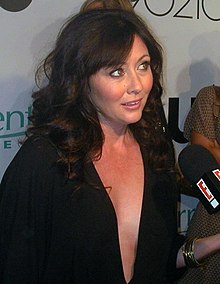
Doherty attending the premiere of 90210 in 2008
American actress Shannen Doherty has appeared in numerous television programs and motion pictures. After her television debut in Father Murphy in 1981, she landed her first major role in the dramatic western television series Little House on the Prairie (1982–1983), and reprised her role in its three television specials. Doherty received two Young Artist Award nominations for playing the oldest Witherspoon sibling Kris in the family drama Our House (1986–1988). She appeared in four films during the 1980s, including the positively-received, animated film The Secret of NIMH (1982) and the cult classic Heathers (1988). Her breakthrough role was as Brenda Walsh in the teen drama Beverly Hills, 90210 (1990–1994), but she was later dropped from the series because of backstage issues and her negative image as a "bad girl". She starred in television films in the early and mid-1990s, and played Rene Mosier in the romantic comedy Mallrats (1995) in an attempt to rebuild her career.
Doherty enjoyed a resurgence in popularity after being cast by producer Aaron Spelling to play Prue Halliwell on the supernatural drama Charmed (1998–2001). The series was their second collaboration following Beverly Hills, 90210. The character was praised by critics and fans, earning a spot as one of the best witches in television history according to a TVLine article, and Doherty took an active role in the show's production, directing three of its episodes. Following disagreements with Spelling and co-star Alyssa Milano, Doherty left the series in its third season. Doherty starred in a string of television films and had a recurring role on the prime-time soap opera North Shore (2004–2005). The following year, she was cast as Denise Johnson in the unaired pilot of the sitcom Love, Inc., but was dropped from the show by producers from United Paramount Network (UPN). She reprised her role as Brenda Walsh in the reboot of 90210 (2008–2009), appearing as a special guest star in seven episodes in its first season. (Full article...)Image 8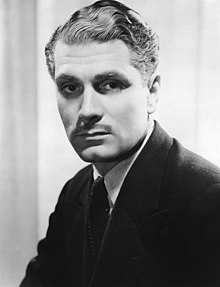
Laurence Olivier in a promotional still for Rebecca (1940).
Laurence Olivier (1907–1989) was an English actor who, along with his contemporaries Ralph Richardson and John Gielgud, dominated the British stage of the mid-20th century. He also worked in films throughout his career, playing more than fifty cinema roles. From 1935 he performed in radio broadcasts and, from 1956, had considerable success in television roles.
After attending drama school, Olivier began his professional career with small touring companies before being taken on in 1925 by Sybil Thorndike and her husband, Lewis Casson, as a bit-part player, understudy and assistant stage manager for their London company. In 1926 he joined the Birmingham Repertory Company, where he was given the chance to play a wide range of key roles. In 1930 he had his first important West End success in Noël Coward's Private Lives, and in 1935 he played in a celebrated production of Romeo and Juliet alongside Gielgud and Peggy Ashcroft, and by the end of the decade he was an established star. In the 1940s, together with Richardson and John Burrell, Olivier was the co-director of the Old Vic, building it into a highly respected company. There his most celebrated roles included Shakespeare's Richard III and Sophocles's Oedipus. In the 1950s Olivier was an independent actor-manager, but his stage career was in the doldrums until he joined the avant garde English Stage Company in 1957 to play the title role in The Entertainer. From 1963 to 1973 he was the founding director of Britain's National Theatre, running a resident company that fostered many future stars. His own parts there included the title role in Othello (1964) and Shylock in The Merchant of Venice (1970). (Full article...)Image 9No.
overallNo. in
seasonTitle Directed by Written by Original air date Prod.
codeU.S. viewers
(millions)129 1 "Who Shot Mr. Burns? (Part Two)" Wes Archer Bill Oakley & Josh Weinstein September 17, 1995 (1995-09-17) 2F20 22.6 130 2 "Radioactive Man" Susie Dietter John Swartzwelder September 24, 1995 (1995-09-24) 2F17 15.7 131 3 "Home Sweet Homediddly-Dum-Doodily" Susie Dietter Jon Vitti October 1, 1995 (1995-10-01) 3F01 14.5 132 4 "Bart Sells His Soul" Wes Archer Greg Daniels October 8, 1995 (1995-10-08) 3F02 14.8 133 5 "Lisa the Vegetarian" Mark Kirkland David X. Cohen October 15, 1995 (1995-10-15) 3F03 14.6 134 6 "Treehouse of Horror VI" Bob Anderson John Swartzwelder October 29, 1995 (1995-10-29) 3F04 19.7 Steve Tompkins David X. Cohen 135 7 "King-Size Homer" Jim Reardon Dan Greaney November 5, 1995 (1995-11-05) 3F05 17.0 136 8 "Mother Simpson" David Silverman Richard Appel November 19, 1995 (1995-11-19) 3F06 15.3 137 9 "Sideshow Bob's Last Gleaming" Dominic Polcino Spike Feresten November 26, 1995 (1995-11-26) 3F08 14.2 138 10 "The Simpsons 138th Episode Spectacular" David Silverman Jon Vitti December 3, 1995 (1995-12-03) 3F31 16.4 139 11 "Marge Be Not Proud" Steven Dean Moore Mike Scully December 17, 1995 (1995-12-17) 3F07 16.7 140 12 "Team Homer" Mark Kirkland Mike Scully January 7, 1996 (1996-01-07) 3F10 16.7 141 13 "Two Bad Neighbors" Wes Archer Ken Keeler January 14, 1996 (1996-01-14) 3F09 16.5 142 14 "Scenes from the Class Struggle in Springfield" Susie Dietter Jennifer Crittenden February 4, 1996 (1996-02-04) 3F11 14.4 143 15 "Bart the Fink" Jim Reardon Story by : Bob Kushell
Teleplay by : John SwartzwelderFebruary 11, 1996 (1996-02-11) 3F12 15.0 144 16 "Lisa the Iconoclast" Mike B. Anderson Jonathan Collier February 18, 1996 (1996-02-18) 3F13 13.4 145 17 "Homer the Smithers" Steven Dean Moore John Swartzwelder February 25, 1996 (1996-02-25) 3F14 14.1 146 18 "The Day the Violence Died" Wes Archer John Swartzwelder March 17, 1996 (1996-03-17) 3F16 14.4 147 19 "A Fish Called Selma" Mark Kirkland Jack Barth March 24, 1996 (1996-03-24) 3F15 12.9 148 20 "Bart on the Road" Swinton O. Scott III Richard Appel March 31, 1996 (1996-03-31) 3F17 11.8 149 21 "22 Short Films About Springfield" Jim Reardon Richard Appel, David X. Cohen, Jonathan Collier,
Jennifer Crittenden, Greg Daniels, Brent Forrester,
Rachel Pulido, Steve Tompkins, Bill Oakley,
Josh Weinstein & Matt GroeningApril 14, 1996 (1996-04-14) 3F18 10.5 150 22 "Raging Abe Simpson and His Grumbling Grandson
in 'The Curse of the Flying Hellfish'"Jeffrey Lynch Jonathan Collier April 28, 1996 (1996-04-28) 3F19 13.0 151 23 "Much Apu About Nothing" Susie Dietter David X. Cohen May 5, 1996 (1996-05-05) 3F20 11.3 152 24 "Homerpalooza" Wes Archer Brent Forrester May 19, 1996 (1996-05-19) 3F21 12.9 153 25 "Summer of 4 Ft. 2" Mark Kirkland Dan Greaney May 19, 1996 (1996-05-19) 3F22 14.7
'"`UNIQ--templatestyles-0000001A-QINU`"'
(Full article...)Image 10The episodes of the anime series Gunslinger Girl are based on the Gunslinger Girl manga series written and illustrated by Yu Aida. There are a total of twenty-eight episodes split over two seasons/series. Set in modern-day Italy, the series revolves around the Social Welfare Agency, a government-funded organisation which is supposed to provide advanced medical care to those in need. This, however, is a cover for a far different agenda: the patients, adolescent girls who have survived traumatic events, are brainwashed into forgetting their past, turned into cyborgs, trained in the use of weapons and used as assassins to battle enemies of the State. Each girl is assigned to an adult whose job is to provide the girl with training and act as a mentor and authority figure. The relationship between the cyborg-girls and their "handlers" forms the basis of much of the plot and varies from the affectionate to the indifferent with varying degrees of results.
The first series' episodes were directed by Morio Asaka, animated by Madhouse Studios, and produced by Bandai Visual, Marvelous Entertainment, MediaWorks, and Madhouse Studios. It adapts the first two manga volumes of the series over thirteen episodes which aired in Japan from October 9, 2003 to February 19, 2004 on Bandai Channel and Fuji Television. Set in contemporary Italy, the series tells about young girls who are turned into cyborgs, trained as assassins by adult male "handlers" and their missions against terrorists and gangsters on behalf of a secretive government agency. A sequel called Gunslinger Girl -Il Teatrino-, directed by Hiroshi Ishiodori and animated by Artland, aired in Japan on Tokyo MX TV from January 8, 2008 to April 1, 2008. It adapts the third, fourth and fifth volumes of the manga over fifteen episodes, with thirteen episodes airing on television and the final two released directly to DVD. (Full article...)Image 11No.
overallNo. in
seasonTitle Directed by Written by Original air date Prod.
codeU.S. viewers
(millions)36 1 "Stark Raving Dad" Rich Moore Al Jean & Mike Reiss September 19, 1991 (1991-09-19) 7F24 22.9 37 2 "Mr. Lisa Goes to Washington" Wes Archer George Meyer September 26, 1991 (1991-09-26) 8F01 20.2 38 3 "When Flanders Failed" Jim Reardon Jon Vitti October 3, 1991 (1991-10-03) 7F23 22.8 39 4 "Bart the Murderer" Rich Moore John Swartzwelder October 10, 1991 (1991-10-10) 8F03 20.8 40 5 "Homer Defined" Mark Kirkland Howard Gewirtz October 17, 1991 (1991-10-17) 8F04 20.6 41 6 "Like Father, Like Clown" Jeffrey Lynch & Brad Bird Jay Kogen & Wallace Wolodarsky October 24, 1991 (1991-10-24) 8F05 20.2 42 7 "Treehouse of Horror II" Jim Reardon Al Jean & Mike Reiss October 31, 1991 (1991-10-31) 8F02 20.0 Jeff Martin & George Meyer Sam Simon & John Swartzwelder 43 8 "Lisa's Pony" Carlos Baeza Al Jean & Mike Reiss November 7, 1991 (1991-11-07) 8F06 23.0 44 9 "Saturdays of Thunder" Jim Reardon Ken Levine & David Isaacs November 14, 1991 (1991-11-14) 8F07 24.7 45 10 "Flaming Moe's" Rich Moore & Alan Smart Robert Cohen November 21, 1991 (1991-11-21) 8F08 23.9 46 11 "Burns Verkaufen der Kraftwerk" Mark Kirkland Jon Vitti December 5, 1991 (1991-12-05) 8F09 21.1 47 12 "I Married Marge" Jeffrey Lynch Jeff Martin December 26, 1991 (1991-12-26) 8F10 21.9 48 13 "Radio Bart" Carlos Baeza Jon Vitti January 9, 1992 (1992-01-09) 8F11 24.2 49 14 "Lisa the Greek" Rich Moore Jay Kogen & Wallace Wolodarsky January 23, 1992 (1992-01-23) 8F12 23.2 50 15 "Homer Alone" Mark Kirkland David M. Stern February 6, 1992 (1992-02-06) 8F14 23.7 51 16 "Bart the Lover" Carlos Baeza Jon Vitti February 13, 1992 (1992-02-13) 8F16 20.5 52 17 "Homer at the Bat" Jim Reardon John Swartzwelder February 20, 1992 (1992-02-20) 8F13 24.6 53 18 "Separate Vocations" Jeffrey Lynch George Meyer February 27, 1992 (1992-02-27) 8F15 23.7 54 19 "Dog of Death" Jim Reardon John Swartzwelder March 12, 1992 (1992-03-12) 8F17 23.4 55 20 "Colonel Homer" Mark Kirkland Matt Groening March 26, 1992 (1992-03-26) 8F19 25.5 56 21 "Black Widower" David Silverman Story by : Thomas Chastain & Sam Simon
Teleplay by : Jon VittiApril 9, 1992 (1992-04-09) 8F20 17.3 57 22 "The Otto Show" Wes Archer Jeff Martin April 23, 1992 (1992-04-23) 8F21 17.5 58 23 "Bart's Friend Falls in Love" Jim Reardon Jay Kogen & Wallace Wolodarsky May 7, 1992 (1992-05-07) 8F22 19.5 59 24 "Brother, Can You Spare Two Dimes?" Rich Moore John Swartzwelder August 27, 1992 (1992-08-27) 8F23 17.2
'"`UNIQ--templatestyles-00000019-QINU`"'
(Full article...)Image 12
Niven in the 1948 film Enchantment
The British actor David Niven (1910–1983) performed in many genres of light entertainment, including film, radio and theatre. He was also the author of four books: two works of fiction and two autobiographies. Described by Brian McFarlane, writing for the British Film Institute (BFI), as being "of famously debonair manner", Niven's career spanned from 1932 until 1983.
After brief spells as an army officer, whisky salesman and with a horse racing syndicate, he was an uncredited extra in his screen debut in There Goes the Bride; he went on to appear in nearly a hundred films, the last of which was in 1983: Curse of the Pink Panther. During his long film career, he was presented with a Golden Globe Award for his part in The Moon Is Blue (1953) and was nominated for a BAFTA for the titular lead in Carrington V.C. (1955). For his role as Major Pollock in the 1958 film Separate Tables, Niven was awarded the Academy and Golden Globe awards for a performance where "the pain behind the fake polish was moving to observe". According to Sheridan Morley, Niven's other notable works include The Charge of the Light Brigade (1938), The Way Ahead (1944), A Matter of Life and Death (1946)—judged by the BFI to be one of the top twenty British films of all time—The Guns of Navarone (1961) and the role of Sir Charles Litton in three Pink Panther films. (Full article...)News
Wikinews television portal- December 28: US professional wrestler Jon Huber dies aged 41
- September 2: Tributes paid to recently deceased US actor Chadwick Boseman
- May 24: Japanese professional wrestler and Netflix star Hana Kimura dies aged 22
- January 16: BBC newsreader Alagiah to undergo treatment for bowel cancer
- Upcoming events
Featured content
No.
overallNo. in
seasonTitle Directed by Written by Original air date Prod.
codeU.S. viewers
(millions)14 1 "Bart Gets an 'F'" David Silverman David M. Stern October 11, 1990 (1990-10-11) 7F03 33.6 15 2 "Simpson and Delilah" Rich Moore Jon Vitti October 18, 1990 (1990-10-18) 7F02 29.9 16 3 "Treehouse of Horror" Wes Archer John Swartzwelder October 25, 1990 (1990-10-25) 7F04 27.4 Rich Moore Jay Kogen & Wallace Wolodarsky David Silverman Edgar Allan Poe & Sam Simon 17 4 "Two Cars in Every Garage and Three Eyes on Every Fish" Wes Archer Sam Simon & John Swartzwelder November 1, 1990 (1990-11-01) 7F01 26.1 18 5 "Dancin' Homer" Mark Kirkland Ken Levine & David Isaacs November 8, 1990 (1990-11-08) 7F05 26.1 19 6 "Dead Putting Society" Rich Moore Jeff Martin November 15, 1990 (1990-11-15) 7F08 25.4 20 7 "Bart vs. Thanksgiving" David Silverman George Meyer November 22, 1990 (1990-11-22) 7F07 25.9 21 8 "Bart the Daredevil" Wes Archer Jay Kogen & Wallace Wolodarsky December 6, 1990 (1990-12-06) 7F06 26.2 22 9 "Itchy & Scratchy & Marge" Jim Reardon John Swartzwelder December 20, 1990 (1990-12-20) 7F09 22.2 23 10 "Bart Gets Hit by a Car" Mark Kirkland John Swartzwelder January 10, 1991 (1991-01-10) 7F10 24.8 24 11 "One Fish, Two Fish, Blowfish, Blue Fish" Wes Archer Nell Scovell January 24, 1991 (1991-01-24) 7F11 24.2 25 12 "The Way We Was" David Silverman Al Jean, Mike Reiss & Sam Simon January 31, 1991 (1991-01-31) 7F12 26.8 26 13 "Homer vs. Lisa and the 8th Commandment" Rich Moore Steve Pepoon February 7, 1991 (1991-02-07) 7F13 26.2 27 14 "Principal Charming" Mark Kirkland David M. Stern February 14, 1991 (1991-02-14) 7F15 23.9 28 15 "Oh Brother, Where Art Thou?" Wes Archer Jeff Martin February 21, 1991 (1991-02-21) 7F16 26.8 29 16 "Bart's Dog Gets an 'F'" Jim Reardon Jon Vitti March 7, 1991 (1991-03-07) 7F14 23.9 30 17 "Old Money" David Silverman Jay Kogen & Wallace Wolodarsky March 28, 1991 (1991-03-28) 7F17 21.2 31 18 "Brush with Greatness" Jim Reardon Brian K. Roberts April 11, 1991 (1991-04-11) 7F18 20.6 32 19 "Lisa's Substitute" Rich Moore Jon Vitti April 25, 1991 (1991-04-25) 7F19 17.7 33 20 "The War of the Simpsons" Mark Kirkland John Swartzwelder May 2, 1991 (1991-05-02) 7F20 19.7 34 21 "Three Men and a Comic Book" Wes Archer Jeff Martin May 9, 1991 (1991-05-09) 7F21 21.0 35 22 "Blood Feud" David Silverman George Meyer July 11, 1991 (1991-07-11) 7F22 17.3 Main topics
History of television: Early television stations • Geographical usage of television • Golden Age of Television • List of experimental television stations • List of years in television • Mechanical television • Social aspects of television • Television systems before 1940 • Timeline of the introduction of television in countries • Timeline of the introduction of color television in countries
Inventors and pioneers: John Logie Baird • Alan Blumlein • Walter Bruch • Alan Archibald Campbell-Swinton • Allen B. DuMont • Philo Taylor Farnsworth • Charles Francis Jenkins • Boris Grabovsky • Paul Gottlieb Nipkow • Constantin Perskyi • Boris Rosing • David Sarnoff • Kálmán Tihanyi • Vladimir Zworykin
Technology: Comparison of display technology • Digital television • Liquid crystal display television • Large-screen television technology • Technology of television
Terms: Broadcast television systems • Composite monitor • HDTV • Liquid crystal display television • PAL • Picture-in-picture • Pay-per-view • Plasma display • NICAM • NTSC • SECAM
Categories
WikiProjects

You are invited to participate in WikiProject Television, a WikiProject dedicated to developing and improving articles about Television.
- Main projects
- Sub-projects
Television Stations • American animation • American television • Australian television • British TV • BBC • Canadian TV shows • Television Game Shows • ITC Entertainment Productions • Digimon • Buffyverse • Doctor Who • Degrassi • EastEnders • Episode coverage • Firefly • Futurama • Grey's Anatomy • Indian television • Lost • Nickelodeon • The O.C. • Professional Wrestling • Reality TV • The Simpsons • Seinfeld • South Park • Stargate • Star Trek • Star Wars • Soap operas • Avatar: The Last Airbender • House
- Related projects
Animation • Anime and manga • Comedy • Comics • Fictional characters • Film • Media franchises
What are WikiProjects?
Things you can do

Things you can do - Place the {{WikiProject Television}} project banner on the talk pages of all articles within the scope of the project.
- Write: Possible Possum
- Cleanup: color television, Alien Nation: Body and Soul, The Sopranos, Alien Nation: Dark Horizon, Alien Nation: The Enemy Within, Alien Nation: Millennium, Aang
- Expand: Timeline of the introduction of color television in countries
- Stubs: Flow (television), Just for Kicks (TV series), Play of the Month, Nova (Dutch TV series), More stubs...
Subportals
Related portals
Associated Wikimedia
The following Wikimedia Foundation sister projects provide more on this subject:
-
Commons
Free media repository -
Wikibooks
Free textbooks and manuals -
Wikidata
Free knowledge base -
Wikinews
Free-content news -
Wikiquote
Collection of quotations -
Wikisource
Free-content library -
Wikiversity
Free learning tools -
Wiktionary
Dictionary and thesaurus
Discover Wikipedia using portals
- Portals with triaged subpages from July 2018
- All portals with triaged subpages
- Portals with no named maintainer
- Random portal component with over 50 available subpages
- Random portal component with 21–25 available image subpages
- Random portal component with 31–40 available subpages
- Automated article-slideshow portals with 201–500 articles in article list

